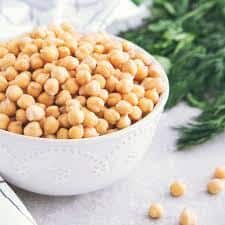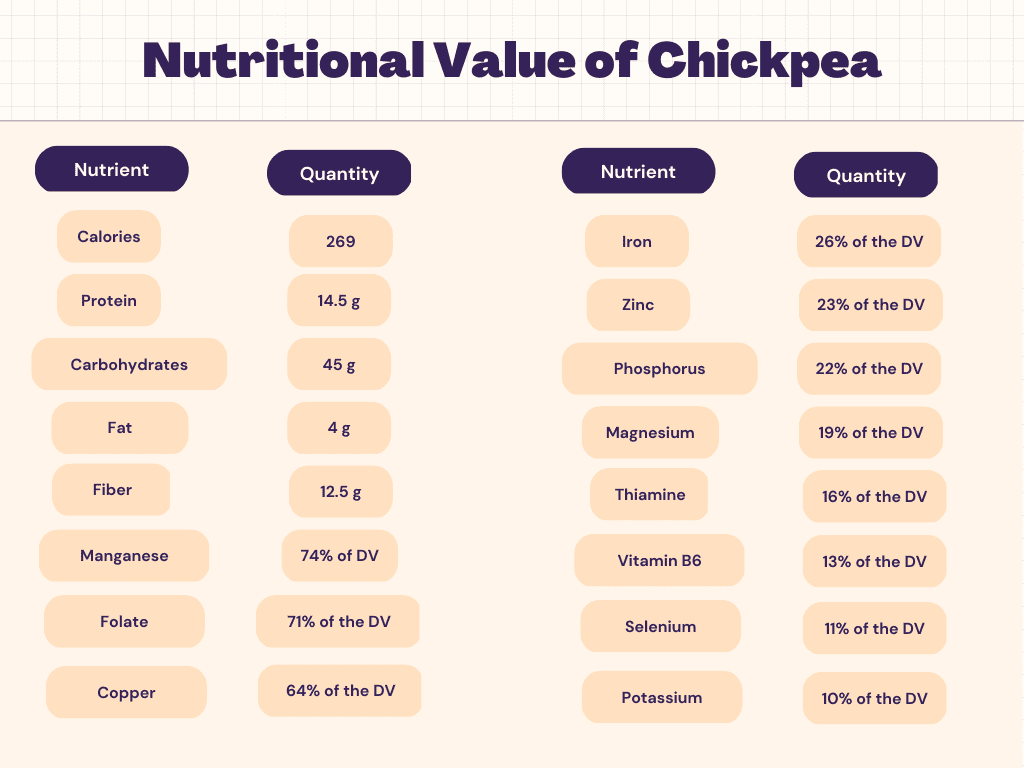Legumes include garbanzo beans, sometimes known as chickpeas. The most typical variety is round and beige in color, but there are also red, green, and black variations. These nutrients have a number of health advantages. Various nutrients are found in chickpeas, including protein, which is essential for the skin, muscles, and bones. For instance, a dish of chickpeas and rice can add a large quantity of protein to the diet of people who do not consume meat or are reducing their meat intake. Around one-third of an adult’s daily protein needs are met by a cup of chickpeas.
Chickpeas aid with blood sugar regulation. Chickpeas in cans and in dried form have a low glycemic index. As a result, they are slowly absorbed and digested by your body. They also include amylose, a form of starch that digests slowly. Both of these contribute to preventing an excessive rise in insulin and blood sugar levels.
Nutritional Value of Chickpea
Nutritional Facts of Chickpeas
Carbs in Chickpeas
Chickpeas are primarily calorie-rich in carbohydrates. A serving of 1 cup contains roughly 35 grams of carbohydrates. Although there is a little amount of naturally occurring sugar in chickpeas, fiber, and starch make up the majority of their carbohydrate content. One cup of chickpeas is thought to have a glycemic load of 23.
Protein in Chickpeas
With 11 grams of plant-based protein per cup, chickpeas are a rich source of this type of protein. Protein plays a crucial role in keeping the immune system strong. It is also a component of muscular tissue and the basis for hair, skin, and nails.
Fats in Chickpeas
Chickpeas contain a modest amount of fat. The majority of it is polyunsaturated fat, which is regarded as a more beneficial kind of fat. Furthermore, chickpeas contain trace levels of saturated and monounsaturated fat.
Health Benefits Of Chickpeas
- Chickpeas aid with blood sugar regulation. Chickpeas in cans and in dried form have a low glycemic index. As a result, they are slowly absorbed and digested by your body. They also include amylose, a form of starch that digests slowly. Both of these contribute to preventing an excessive rise in insulin and blood sugar levels. Those with diabetes will benefit from this.
- They support healthy digestion. Dietary fiber, particularly a soluble fiber known as raffinose, is abundant in chickpeas. This is broken down by the beneficial bacteria in your gut so that your colon can slowly absorb it. More chickpeas in your diet may facilitate simpler, more regular bowel movements, according to studies.
- These might aid in lowering cholesterol. The benefits of soluble fiber extend beyond gut health. It can lower both your LDL (“bad”) and total cholesterol. Your risk of heart disease is decreased as a result. Research has shown that including chickpeas in your diet helps lower your overall cholesterol.
- These might reduce your risk of developing cancer. Your body produces butyrate, a short-chain fatty acid when you consume chickpeas. Butyrate has been shown in tests to aid in the elimination of sick and dying cells. This could reduce your risk of developing colorectal cancer. Other cancer-preventive substances found in chickpeas include lycopene and saponins.
- They strengthen your bones. Chickpeas and other legumes contain fiber, calcium, magnesium, and other minerals that are necessary for healthy bones. Nevertheless, make sure to soak them first to remove substances known as phytates that may prevent your body from absorbing the calcium in chickpeas.
- These might improve your mental well-being. Choline, a vitamin found in chickpeas, aids in the synthesis of molecules in the brain and nervous system that are necessary for memory, mood, muscular control, and other functions.
Vitamins & Minerals in Chickpeas
In a serving of one cup, chickpeas supply 14% of your daily requirements for both folate and vitamin B6. The B vitamins thiamin, riboflavin, niacin, and pantothenic acid are also included. Manganese, phosphorus, copper, iron, magnesium, and minor levels of potassium, selenium, and calcium are among the beneficial elements found in chickpeas.
The bottom line
Chickpeas aren’t just a delicious component of chili and a necessary component of hummus. With their abundance of vitamins, minerals, fiber, and protein, they are also incredibly healthful. These traits may help you manage your weight, regulate your blood sugar, and maintain good brain function while lowering your risk of developing chronic diseases like cancer and heart disease. Check our Weight Loss and Diabetes Plans.
Faqs
How many Chickpeas can I eat in a day?
Every day, you should consume at least one serving (28 grams) of chickpeas. Consume no more than 70 grams daily, though, as doing so may have unfavorable effects. Bloating, nausea, and gas are a few undesirable side effects that might occur if you eat too many chickpeas. It’s crucial to keep in mind that chickpeas shouldn’t be consumed raw.
Should I eat Chickpeas before or after exercise?
Almost exactly, chickpeas conform to the 1:3 protein-to-carb ratio. They are the perfect post-workout food since they have 6 grams of protein for every 20 grams of carbohydrates.
What is the best time to eat Chickpeas?
Can I consume chickpeas after dark? In reality, chickpeas can be eaten at any time of day, so eating them at night is acceptable. Magnesium, vitamin B6, and a substance called tryptophan that promotes restful sleep are all abundant in chickpeas.










